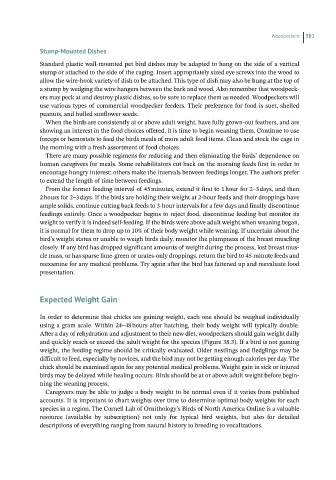Page 580 - Hand rearing birds second
P. 580
Woodpeckers 581
Stump-MountedDishes
Standard plastic wall‐mounted pet bird dishes may be adapted to hang on the side of a vertical
stump or attached to the side of the caging. Insert appropriately sized eye screws into the wood to
allow the wire‐hook variety of dish to be attached. This type of dish may also be hung at the top of
a stump by wedging the wire hangers between the bark and wood. Also remember that woodpeck-
ers may peck at and destroy plastic dishes, so be sure to replace them as needed. Woodpeckers will
use various types of commercial woodpecker feeders. Their preference for food is suet, shelled
peanuts, and hulled sunflower seeds.
When the birds are consistently at or above adult weight, have fully grown‐out feathers, and are
showing an interest in the food choices offered, it is time to begin weaning them. Continue to use
forceps or hemostats to feed the birds meals of more adult food items. Clean and stock the cage in
the morning with a fresh assortment of food choices.
There are many possible regimens for reducing and then eliminating the birds’ dependence on
human caregivers for meals. Some rehabilitators cut back on the morning feeds first in order to
encourage hungry interest; others make the intervals between feedings longer. The authors prefer
to extend the length of time between feedings.
From the former feeding interval of 45 minutes, extend it first to 1 hour for 2–3 days, and then
2 hours for 2–3 days. If the birds are holding their weight at 2‐hour feeds and their droppings have
ample solids, continue cutting back feeds to 3‐hour intervals for a few days and finally discontinue
feedings entirely. Once a woodpecker begins to reject food, discontinue feeding but monitor its
weight to verify it is indeed self‐feeding. If the birds were above adult weight when weaning began,
it is normal for them to drop up to 10% of their body weight while weaning. If uncertain about the
bird’s weight status or unable to weigh birds daily, monitor the plumpness of the breast muscling
closely. If any bird has dropped significant amounts of weight during the process, lost breast mus-
cle mass, or has sparse lime‐green or urates‐only droppings, return the bird to 45‐minute feeds and
reexamine for any medical problems. Try again after the bird has fattened up and reevaluate food
presentation.
ExpectedWeightGain
In order to determine that chicks are gaining weight, each one should be weighed individually
using a gram scale. Within 24–48 hours after hatching, their body weight will typically double.
After a day of rehydration and adjustment to their new diet, woodpeckers should gain weight daily
and quickly reach or exceed the adult weight for the species (Figure 38.3). If a bird is not gaining
weight, the feeding regime should be critically evaluated. Older nestlings and fledglings may be
difficult to feed, especially by novices, and the bird may not be getting enough calories per day. The
chick should be examined again for any potential medical problems. Weight gain in sick or injured
birds may be delayed while healing occurs. Birds should be at or above adult weight before begin-
ning the weaning process.
Caregivers may be able to judge a body weight to be normal even if it varies from published
accounts. It is important to chart weights over time to determine optimal body weights for each
species in a region. The Cornell Lab of Ornithology’s Birds of North America Online is a valuable
resource (available by subscription) not only for typical bird weights, but also for detailed
descriptions of everything ranging from natural history to breeding to vocalizations.

